| Good bye Greenland
Posted by Sandra Reigber on June 11th
Author Georg Fischer
It’s our last evening in Greenland and only Martin and I are still here. Silvan took the plane today and the F-SAR crew is already gone since a few days, as I mentioned in the last blog entry. Thus, it became rather calm around here even so the last week was the complete opposite.
After all radar acquisitions were done and the Do-228 left for Iceland, the last big task for the ground team was to remove all reflectors from the test sites on the ice sheet. For this purpose, we had again a Twin Otter from Kenn Borek Air. Indeed the very same airplane as during the installation phase six weeks ago. The first days started of quite nicely. We managed to remove the reflectors from one test site per day, repeating the ground penetrating radar and snow layering measurements in order to detect temporal changes. Furthermore, we also measured again the position of the reflectors with GPS to determine their displacement. We found the fastest reflectors as expected on the Helheim glacier test site, having moved approximately 18 m within one month due to glacier flow.
And then our pilots came with the bad news from the meteo-office. A weather system was approaching Greenland, giving us only one good day before we will be grounded for a longer period. But we had still two test sites to go.
During the first trips, it appeared that we are slightly faster removing the reflectors compared to installing them, making it only necessary to stay roughly four hours at a test site. Thus, slowly the idea came up to give it a try with two test sites on one day. The pilots crunched some numbers and told us they can reach South Dome and Dye-3 on one day if they bring an extra fuel drum along and if we don’t need more than four hours on each spot. Being aware of the fact that South Dome is the test site where the reflectors have the longest distances between each other and that these remaining two test sites are the highest and therefore coldest ones, we realized the physical challenge behind that plan. Nevertheless, since no one of us wanted to wait for several days for the next good weather period, we gave it a try. We had the feeling that we can make it if the conditions are not too extreme, because particularly strong winds are slowing down any work you want to do on the ice cap.
And we were lucky. Even though it was cold down to -22°C, the wind speed was rather low. We gave our best and also the Kenn Borek crew helped us a lot with digging our installations out of the snow. Finally, we returned back to Kangerlussuaq after a long day, having all reflectors removed from the ice, being very tired but also relieved and happy.
I personally want to thank everyone of our campaign team for their great effort, the good spirit and strong motivation, which allowed our stay in Greenland to be so successful. A big thank you for their support goes also to researchers at AWI and ETH Zurich, to DALO for their collaboration, which made this campaign possible, to the crews of Kenn Borek Air and last but not least to the local people in Kangerlussuaq, especially at Air Greenland. I had a great time here!
And now, let’s go home.
Georg
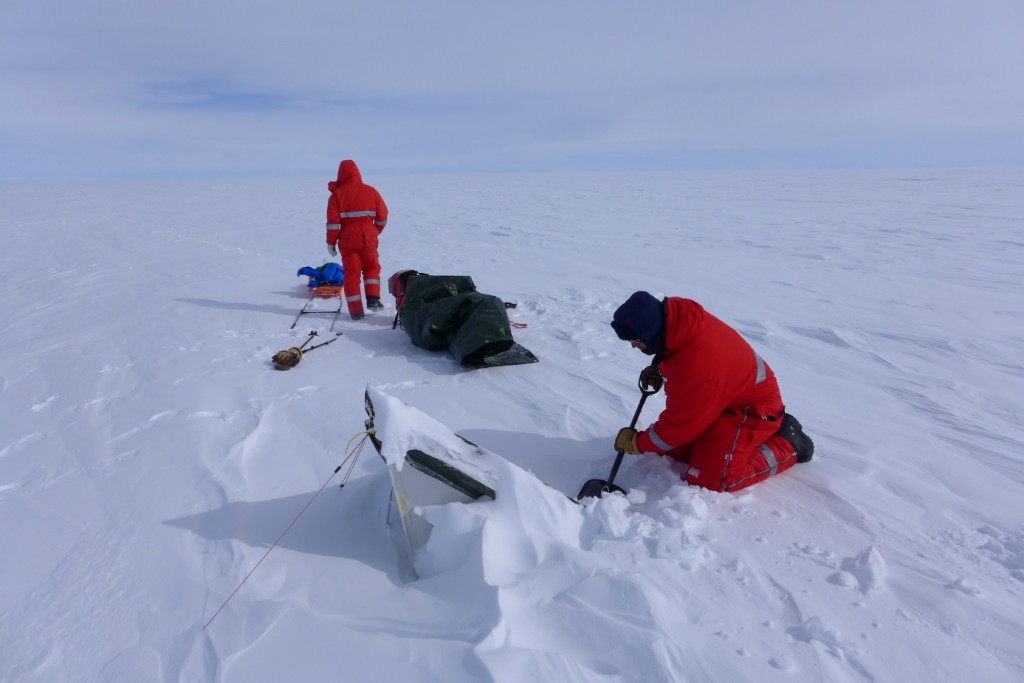 Let’s get ready for shoveling. At Dye-3 the reflectors were covered by up to 30 cm of new snow and don’t forget the 1.20 m long wooden poles that they are mounted on (Picture by Silvan Leinss). 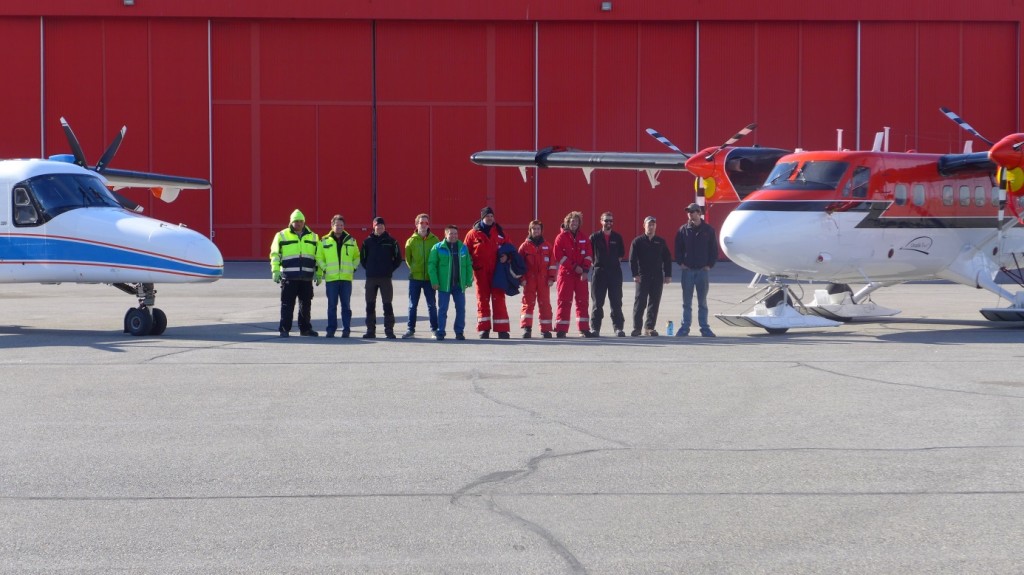 From left to right: The Do-288 airplane, mechanic Vlatko, pilots Steffen and Thomas, radar operator Daniel, campaign leader Ralf, ground team Martin, Georg and Silvan, and the Kenn Borek crew Jørgen, Braden and Anders with their Twin Otter (Picture by Per Mikkelsen/Silvan Leinss). [back]
|
| A completely new test site
Posted by Sandra Reigber on June 1st
Author Georg Fischer
Have you ever thought that it is difficult to write regularly about field trips when everything is running smoothly? If a little catastrophe keeps you busy every day and a couple of unforeseen things happen, you got way more things to tell. But I don’t want to complain, because unexpected issues are exactly what you don’t want to happen during a campaign.
Since the P-band antenna was mounted, all data acquisitions worked out as planned. That means the amount of interferometric and polarimetric SAR data from different test sites on the ice cap increased even further. One particular area at the east coast of Greenland was flown in a nadir looking sounder mode. The idea behind this is to detect some airplanes which made a forced landing there during World War II, and are now buried below approximately 100 m of snow and ice. Unfortunately, we can’t tell yet if this was successful, because the processing of the data will take a couple of weeks. After a week, the P-band antenna was removed again from the Do-228 airplane in order to switch back to the X-C-S-L configuration.
A nice fact that happened unforeseen was that both changes of antenna configuration were finished a lot faster than it usually takes back at home. We were wondering where this comes from. Is it because here in Greenland everyone involved was just concentrating on mounting the antenna setup without being busy with other things of the daily routine at home? Or is it because we kept ourselves motivated by making some effort to enjoy dinners like Swiss Cheese Fondue or Bavarian style Schweinebraten? Either way, this fact allowed us to have an extra day for flight operations. A chance which the scientists among us immediately took to spontaneously make the planning for an additional test site.
Based on preliminary images, it seems like we might be able to detect different ice conditions which are related to subsurface temperature and the appearance of melt water lakes during summer. Therefore, after some phone calls from Kangerlussuaq to Zurich, the study of different radar and optical satellite images, the involvement of the glaciology experts of ETH Zurich, and a quite strict deadline on the evening before the last flight day, we came up with a new test site. It is an area where glaciologists drilled bore holes into the ice, measuring temperature among other parameters, which hopefully allows us to better understand what we see in our radar data and might prove or disprove our first theories.
When our campaign leader came back from the Friday afternoon flight and saw the plan for this new test site, knowing that the following day is the last possibility for it, he was, let’s say, not amused. His reaction was actually absolutely understandable, because naturally we could not hold back and asked for the full acquisition program. After the dust settled a bit, he started to share our fascination for the new test site and spent the evening hours on the flight planning, making it possible to acquire a completely new test site on the very last day. Big thumps up for this!
Few days later, we said good bye to the crew of the Do-228 and thanked the pilots, the engineer and the radar operators for their remarkable effort during our ARCTIC15 campaign. They are now in Iceland for a different project and guess what they are doing there. Of course, acquiring radar data.
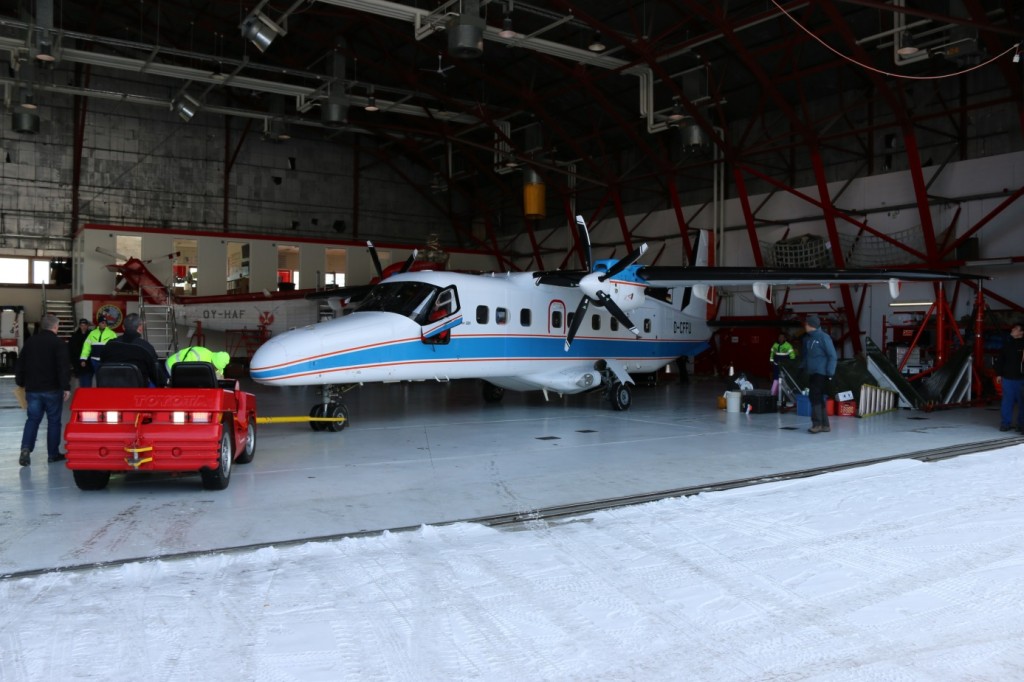 The Do-228 being parked into the hangar in Kangerlussuaq after a measurement flight (Picture by Ralf Horn) 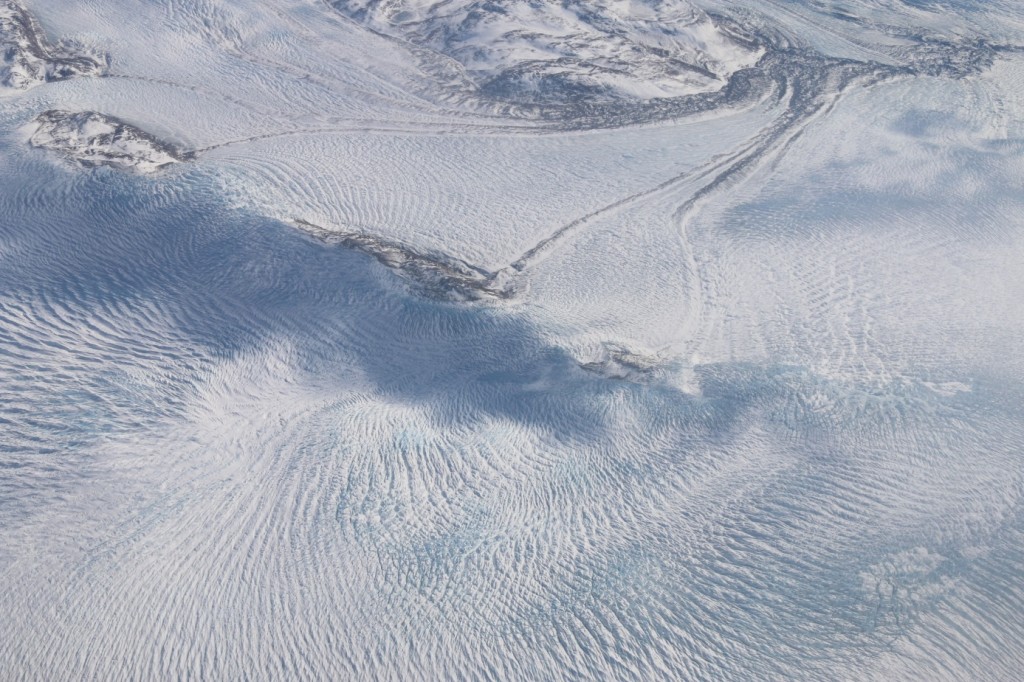 Spectacular crevasse patterns are a nice reward for the F-SAR team after flying demanding measurement tracks (Picture by Ralf Horn) [back]
|
| Airborne SAR acquisitions up and running
Posted by Sandra Reigber on May 15th
Author Georg Fischer
Three calibration flights, ten flights to test sites, and over 100 radar data sets resulting in 4.8 Terabyte of SAR data. These are the numbers behind the work our F-SAR team did within the last two weeks. Including even the alteration from the X-C-S-L to the P-band antenna configuration and fortunately only one bad weather day.
DLR’s Do-228 airplane with the F-SAR system on board arrived on Friday the 24th of May in Kangerlussuaq. Right on the next Monday, the team consisting of two pilots, one flight engineer and two radar operators took off for the first calibration flight. In the first two weeks, the antenna configuration for the X-, C-, S- and L-band frequencies was installed on the plane. This range of different frequencies will allow us to compare radar acquisitions with different penetration depths into the snow and ice. The team acquired SAR data over all the test sites where we had installed corner reflectors. Additionally, the area around the airport and town of Kangerlussuaq is overflown for calibration purposes and is well equipped with seven reflectors. It seems like the local people got used to these strange metallic things in their town pretty fast.
Eventually, during the first days after the calibration flight, we had to face exactly those smaller and bigger problems, which one has always to expect during a campaign, as mentioned in the previous post. But the F-SAR team showed their problem solving skills and campaign experience. From non-matching connections of the local oxygen supply to unstable electronic parts, they were able to fix everything without causing any delay to the campaign plan. I have to admit that I was already worried about losing one test site due to the technical difficulties, but the team was able to acquire almost all the data we had planned for. For now, we can say that the X-C-S-L phase was successful, giving us plenty of scientific data.
Yesterday, the change to the P-band antenna configuration was completed. The P-band wavelength is the longest we will use during this campaign and penetrates several tens of meters into the ice. We are already curious what kind of subsurface features we will see in the data. Today, while I’m writing, the F-SAR team is flying over the K-transect to do the first P-band acquisitions. Currently, we are all very optimistic about upcoming part of the campaign.
And in the meanwhile, spring arrived here in Greenland at sunny +8°C.
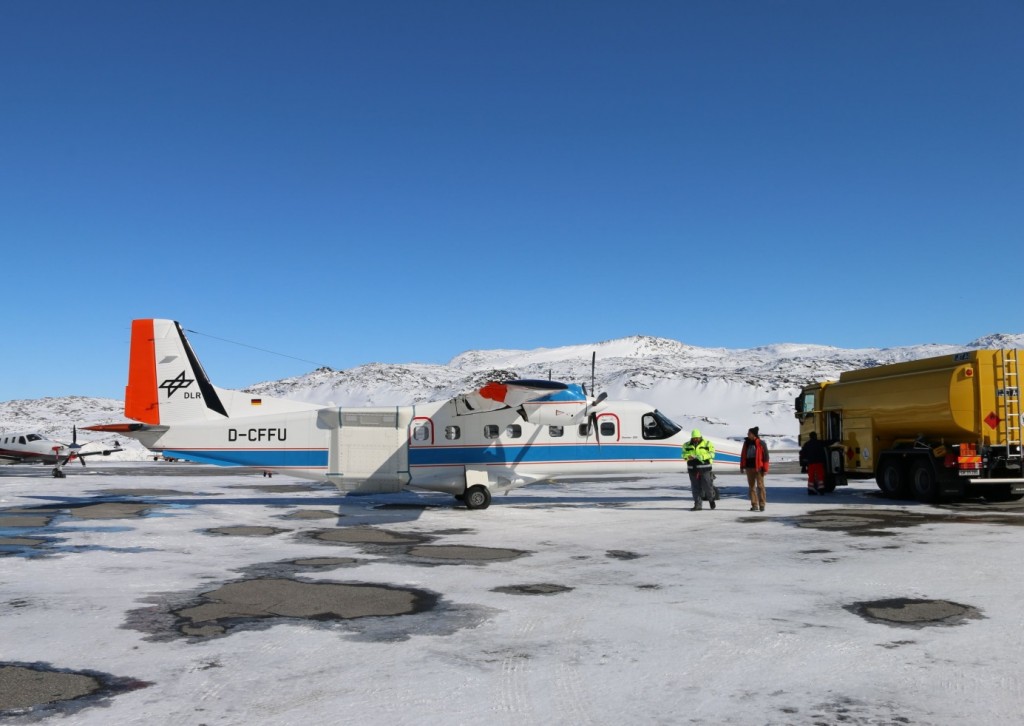 DLR’s Do-228 with the F-SAR radar system on board after refueling at the airport of Ilulissat, Greenland. The X-C-S-L antenna mount is visible on the rear of the plane. (Picture by Ralf Horn) 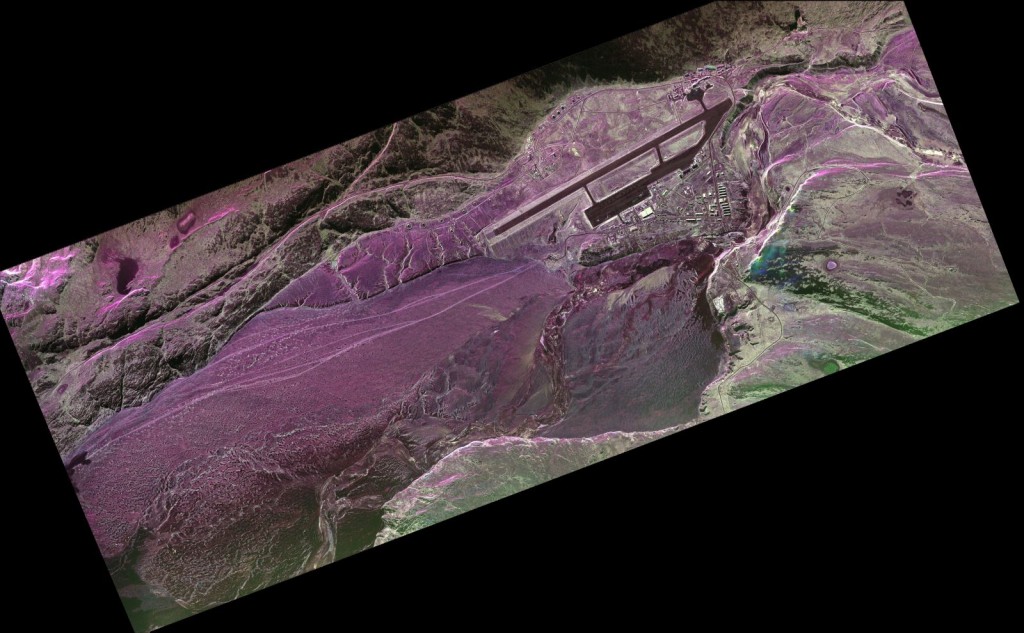 A first SAR data quicklook of the Kangerlussuaq calibration test site. The colors represent the intensity in different polarizations (Red: VV, Green: HV, Blue: HH). The airport is clearly visible in black. From the middle of the image, the fjord extents towards south-west, where skidoo-tracks to the next village can be seen. (Image processed by Martin Keller) 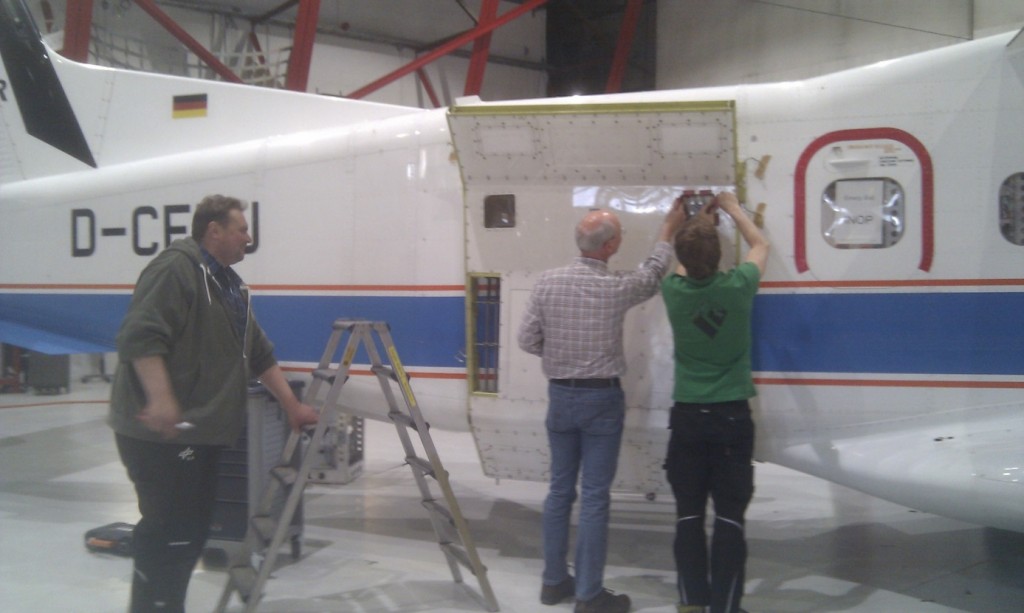 The F-SAR team making preparations to remove the X-C-S-L antenna from the side of the Do-228 airplane. (Picture by Georg Fischer) [back]
|
| Installation phase was a full success
Posted by Sandra Reigber on May 7th
Author Georg Fischer
During the planning of the ARCTIC15 campaign, we always told ourselves to not expect everything to work out perfectly. We thought, we will have at least one test site where we cannot install the corner reflectors, due to weather, risky landing conditions or all the other smaller and bigger things that can go wrong on a field campaign. But finally, we managed to prepare all five test sites successfully!
As Martin wrote already in the last blog entry, the flights with the Twin Otter of Kenn Borek Air were already a full success on their own. We reached four test sites within five days, installed the corner reflectors and did all the measurements as we planned to do. At South Dome, our highest test site, we had such good conditions at -22°C, low winds, good visibility and a hard packed snow surface, that we could even place corner reflectors as far as one kilometer away from our landing spot. On the contrary, at the Dye-3 test site, the wind was blowing with 30 knots and more, causing a strong snow drift and visibility below 250m. Fully relying on compass and GPS to find back to the airplane, we had to limit the distances we covered to about 600 m.
After this success, the biggest challenge remained at the last test site, which stretches from the edge of Russel Glacier 25 km onto the ice cap and is aligned with the so called K-Transect. Delayed two days by weather, we finally took off from Kangerlussuaq with the big Sikorsky S61 helicopter of Air Greenland last Thursday. A short, spectacular flight of about 15 minutes later, we could see the challenging conditions with our own eyes. The first part of the test site was covered by incredibly huge and deep crevasses, which made a landing impossible. Also the second part was still too rugged for the Sikorsky. It needs a flat area to stand on its wheels and crevasses filled with fresh snow are quite a bad choice. Three failed landing attempts later, we had to switch to our backup plan and land on solid ground just next to the glaciers edge. There, the corner reflectors are still well within our planned radar acquisitions strip and are even accessible by all-terrain vehicles. Despite being a bit sad about having no reflectors on top of the glacier at this test site, it was also a relief that we didn’t had to take the risk of walking around in such a heavily crevassed area, even though we were well prepared for this by Silvan, our expert in all mountaineering related topics.
Having all test sites successfully installed, leaves the work now to the F-SAR team who is already busy doing SAR acquisitions since about one week. But more on this in the next blog entry.
It was an incredible experience to work in such a remote and harsh environment! Thanks to Martin and Silvan for being such a great team.
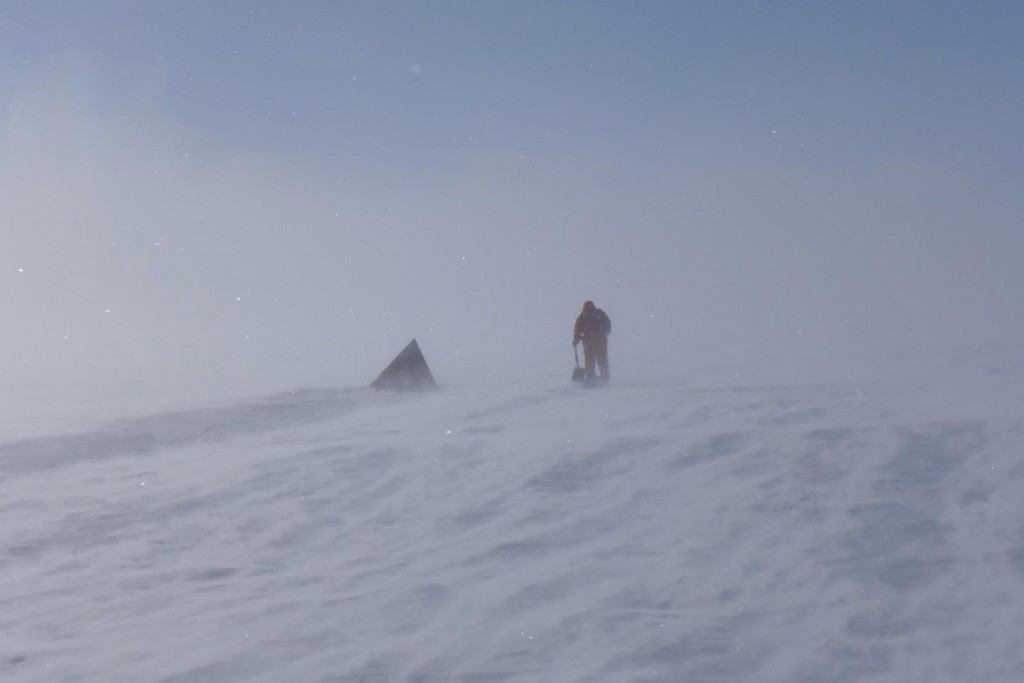 The one side of working on the Greenland Ice Sheet. Stormy conditions with a lot of blowing snow and low visibility made it quite a fight on that day. (Picture by Silvan Leinss)  The other, more beautiful side of field work. -22°C without wind on a sunny day can feel quite warm and comfortable. Perfect working conditions! (Picture by Silvan Leinss) 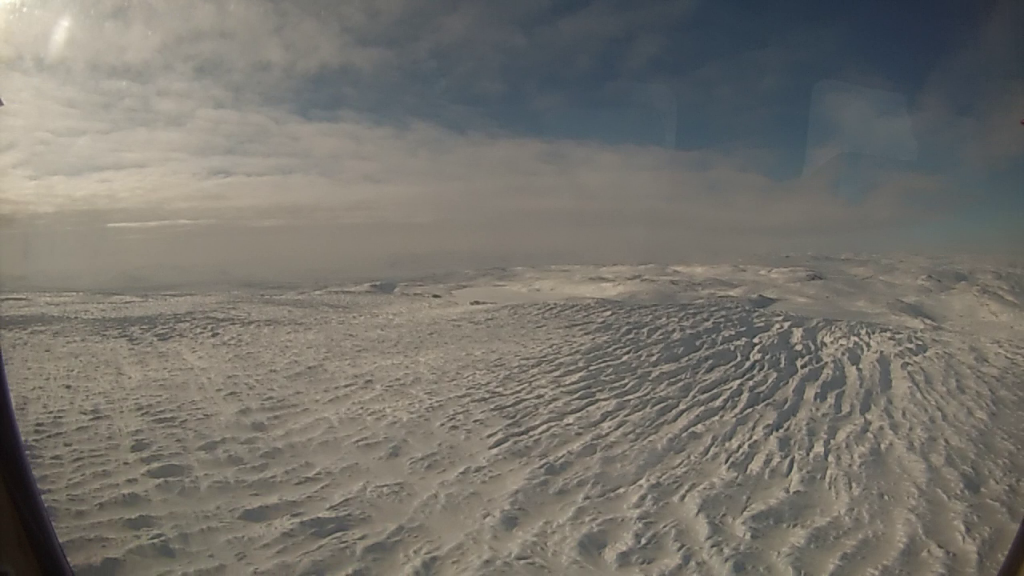 View from the helicopter over the K-Transect test site, showing the impossible landing conditions. (Picture by Georg Fischer) [back]
|
| Preparation of the test sites
Posted by Sandra Reigber on April 29th
Author Martin Keller
Last week we were totally busy with the preparation of our test sites, so that we had no time to blog before. It was quite challenging to load our equipment in the Twin Otter. We knew the dimensions of the freight door but we were surprised that the limiting factor is not the door but the inner space of the aircraft. Luckily, our new reflectors were small enough to fit in the aircraft, but one of our older reflectors had to be cut at one edge.
The Kenn Borek crew who flew us and our material to four different test sites on the ice cap has a lot of experience in arctic conditions. We felt ourselves in good hands with our pilots, even at the landing in stormy (30-35kt) wind with a lot of snow drift. On top of this, the crew was also really helpful and had a good spirit and the necessary flexibility.
The installation of our equipment (corner reflectors and GNSS systems), as well as the ground measurements (ground penetrating radar and snow depth measurements) were really time consuming especially under these cold and windy conditions and with the thick working gloves we had to wear. Every task required much more time than under “normal” climate conditions. Furthermore, it was quite exhausting to pull the ground penetrating radar system and the heavily loaded pulka around at soft snow conditions. Luckily, most of our test sites had a rather hard, wind compacted surface. Hats off to Silvan and Georg, who have carried out this work
 Test loading of our largest radar reflector into the Twin Otter. (Picture by Silvan Leinss) 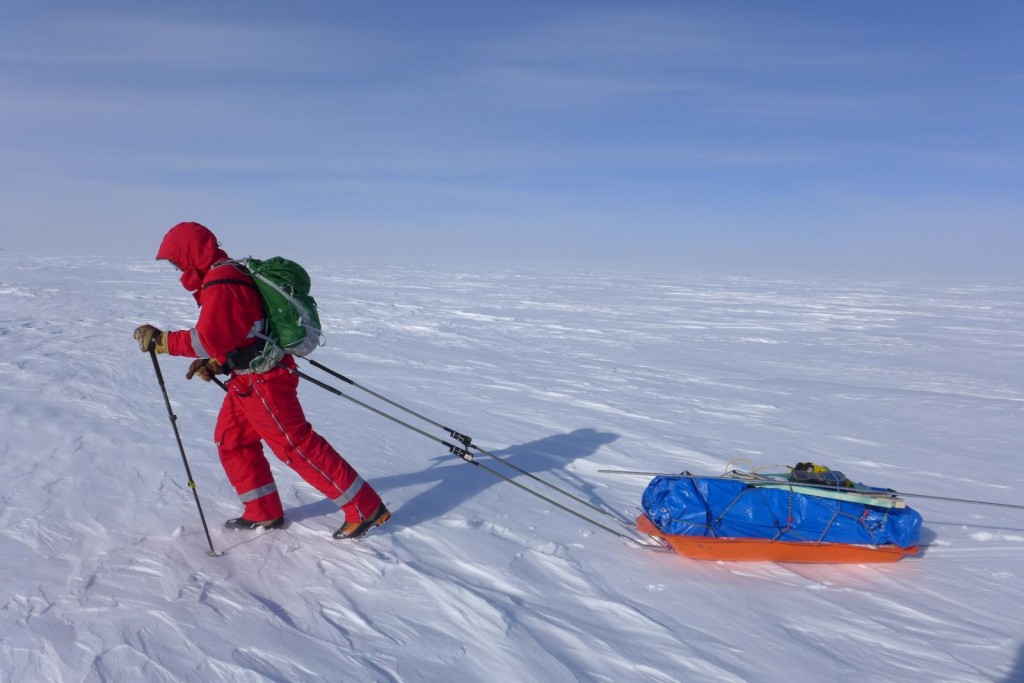 Silvan pulled the pulka with installation material to two positions up to 1km from the aircraft at each test site. (Picture by Silvan Leinss) 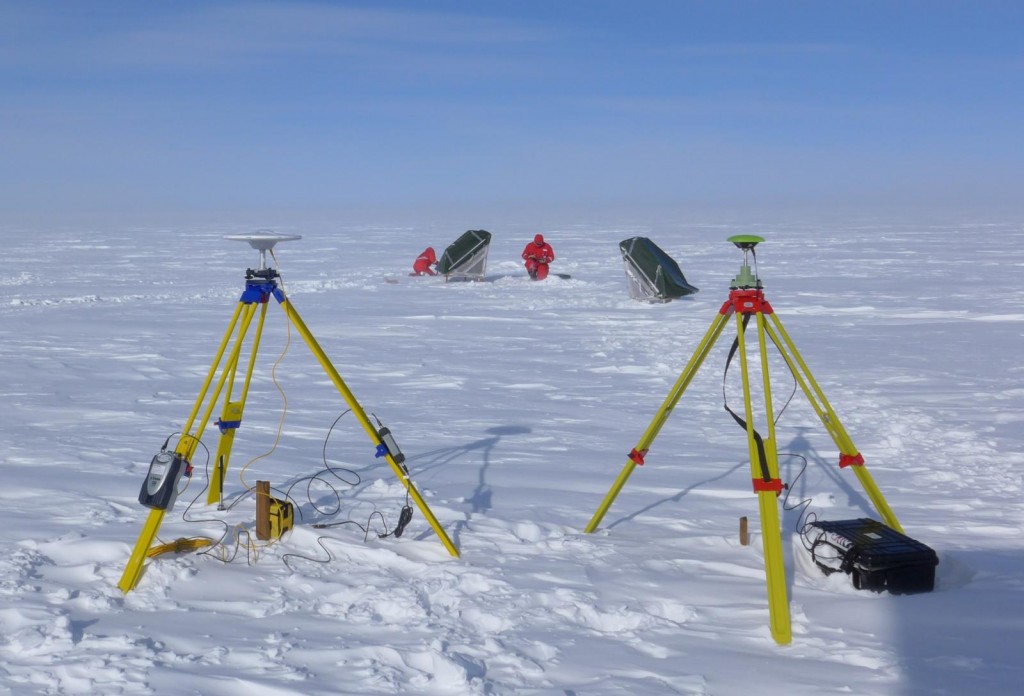 Georg and Martin installing the radar reflectors. In the foreground two GNSS base stations have been placed. (Picture by Silvan Leinss) Despite all these physical efforts, we were able to approach all four test sites by aircraft and prepare these for the F-SAR measurements. Today we wanted to install our equipment at our last test site close to Kangerlussuaq. This region is characterised by many crevasses and is therefore only reachable with helicopters. Unfortunately, in the meantime the weather closed in, so that the pilots decided to shift the flight until Thursday.
Last Thursday, the DLR Do-228 aircraft with the F-SAR arrived in Kangerlussuaq. The transfer was a bit delayed due to bad weather conditions on the route. Yesterday and today, we successfully carried out three acquisitions with the F-SAR. Until now, the recorded data were just backed up. However, as far as I can see at the moment everything looks quite good.
Best wishes from Greenland
Martin
[back]
|
| Arrival at Kangerlussuaq
Posted by Sandra Reigber on April 29th
Author Martin Keller
After 5 hours flight and one stopover in Copenhagen, Georg and I arrived in Kangerlussuaq (Greenland) on April 16th. At the moment it is sunny with temperatures at -15°C. Currently, we unpack our flight cases, assemble the radar reflectors and wrap them in protective foil in order to make them snow proof. Later, we will transport them with a Twin Otter aircraft and a Sikorsky S61 helicopter to the Greenlandic ice cap. Luckily, we are allowed to use the heated hangar of Air Greenland. Without that possibility it would be really difficult to prepare our stuff. The people of Air Greenland are incredibly helpful.
 Arrival in Kangerlussuaq after the direct flight from Copenhagen. (Picture by Martin Keller) 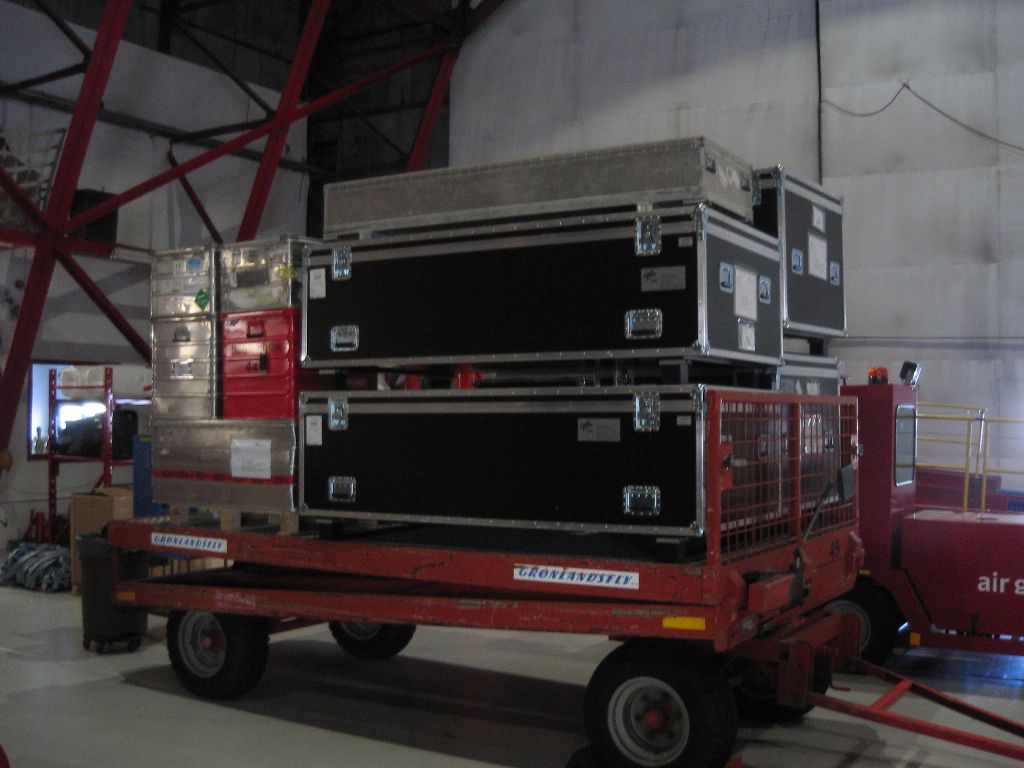 Our flight cases, carefully packed on top of each other. (Picture by Martin Keller) 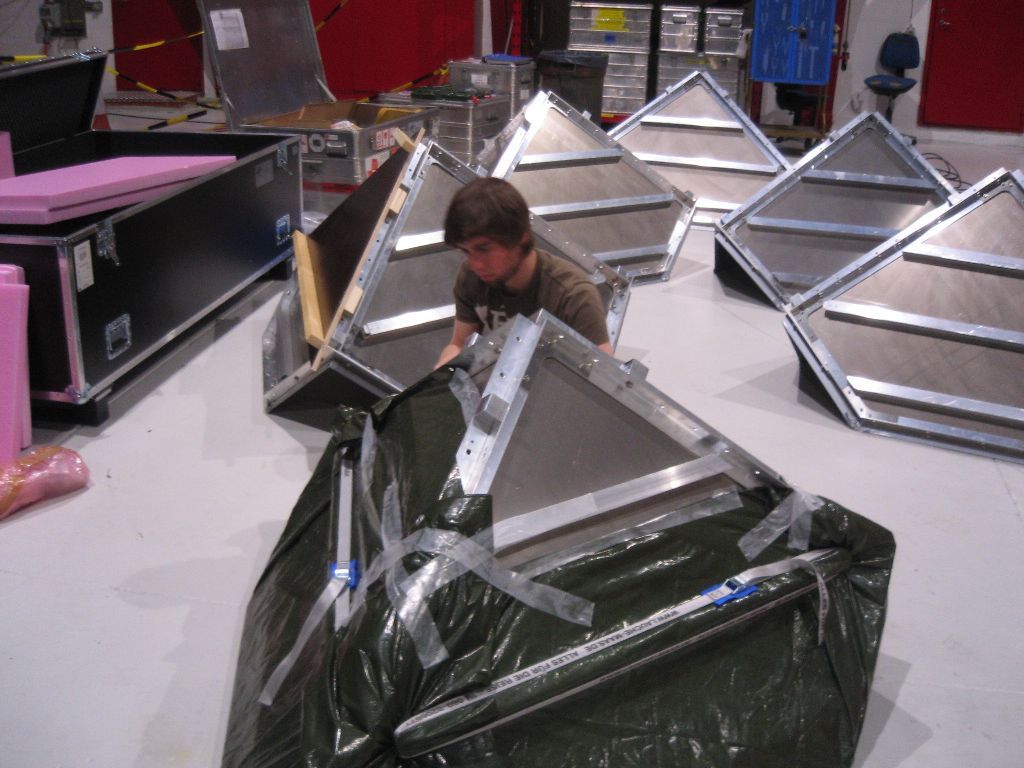 Georg preparing the corner reflectors in the Air Greenland Hangar in order to make them snow proof. This was a quite important preparatory step, because working with the foil and tape would have been impossible at the temperature and wind conditions on the ice cap. (Picture by Martin Keller) [back]
|
















